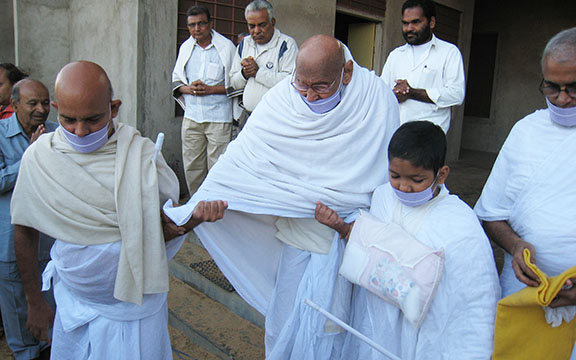
Photo: Eyes always trained on the ground as they walk, these Jain mendicants also carry small brooms to sweep anything from their path so as not to harm a single living creature.
In this column, Rev. Dale Ann Gray offers reflections on the yamas and niyamas of the Yoga Sutras, incorporating insights from classical Nondual Yoga. In this article, she unpacks the first yama, ahimsa (non-violence, non-harming).
In the Yoga Sutras of Patanjali, ahimsa stands as the foundational yama upon which all the other yamas and niyamas, and indeed, the other six limbs of Yoga rest. The great fifth century C.E. sage Vyasa, the first and primary commentator on the Yoga Sutras, defines ahimsa as not injuring any living creature anywhere at any time.
A later interpreter enhanced it to include non-harming of trees. Highly observant Jains go so far as to wear gauze over the face, strain water, refrain from eating root vegetables, and sweep the road before them in order not to harm even the smallest insect or microbe. The limit of this practice is death, some even sacrificing their physical bodies through fasting so as not to cause injury.
While ahimsa is a foundational practice of Yoga, it can also have its near enemies: It can be used as a guilt-inducing tactic by Yoga teachers who pride themselves on vegetarian diets and humiliate or shame students to emulate them. Or, it can be held as a goal or a law somewhere out in the distant future only to be achieved through hard work and discipline. Can you hear the dissonance? This too, can cause harm, injury and violence.
How might we hear nonviolence in a nondual way, not pitting one end of an extreme against any other? Rather than hearing hard and fast declarations of right and wrong, perhaps we could listen to a continuum from violence to a polar opposite and find ourselves on this spectrum. Patanjali says “not this, not violence, not harm.” In the middle, at the zero point, where harm is no more, what begins to sound?
How and where in your body do you feel the absence of violence, harm, injury? It’s difficult to feel into “not” something, isn’t it? Rather than merely stopping the violence, harm or injury, what if we intend its opposite? Patanjali offers this approach in pratipaksha bhavana (sutra 2.33) in which we can invite the opposite positive. If it’s all right, you might choose a word from a list of possible opposites to violence, harm or injury and feel into that in your body.
These opposites might include: gentleness, healing, mending, tending, fending, helping to preserve, protection, blessing, defense, guarding, security, fortifying, shelter, refuge, sanctuary, comfort, support, ease, relief, kindness, peace, compassion, love, tranquility, serenity, quietude, calm, delight, pleasure, joy, bliss, equanimity, harmony, justice, integrity, equity, fairness, assistance, reparation, service, mercy.
Just choose one that sings to you. Can you hear the song? Even if you cannot, you might sincerely pretend that you can. Swami Satchidananda often taught that this is one way to cultivate an opposite positive. By feeling into (or even pretending into it) you may notice that the sensation of this opposite positive is already present, is already who you are, one with the song, or at least pointing to it. This embodied sense of harm’s opposite tunes you to wholeness. Dive deeply into this feeling in the body and notice if you hear a lullaby of Awakening to your Essential Nature. . . or sincerely pretend!
About the Author:
 Rev. Dale Ann Gray, PhD is a Yoga, pranayama and meditation, and Level 2 iRest teacher. She leads workshops, offering private classes and teaching in studios, churches, and online. She is also an ordained minister in the United Church of Christ and holds a Ph.D. in Theology.
Rev. Dale Ann Gray, PhD is a Yoga, pranayama and meditation, and Level 2 iRest teacher. She leads workshops, offering private classes and teaching in studios, churches, and online. She is also an ordained minister in the United Church of Christ and holds a Ph.D. in Theology.

